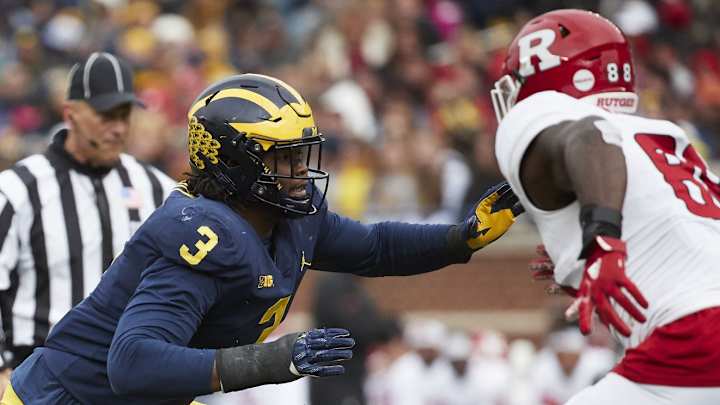Revisiting Michigan's All-Time Top 100 Recruits: No. 1 Rashan Gary

Using 247Sports.com, dating back to the 2000 recruiting class, just once has a school in the Big Ten (or Notre Dame) secured the No. 1 overall prospect in the country - when Michigan signed Rashan Gary in 2016.
Eight of the No. 1's signed in the ACC (four to Clemson alone) while eight signed in the SEC, three in the Pac 12 and two in the Big 12.
Many of the top rated recruits in a class are household names today: Trevor Lawrence, Leonard Fournette, Adrian Peterson, Vince Young, Jadeveon Clowney and Ernie Sims to name a few. Gary doesn't belong in that company, but the question that persists more than a year after he left Michigan following his junior season is: did Gary meet expectations?
The answer to that question almost certainly depends on the lens in which you're looking through.
Gary was a first-round pick of the Green Bay Packers in the 2019 NFL Draft, going No. 12 overall, a selection confirming the immense talent and potential to dominate as a pass rusher that made 247Sports.com, Rivals.com and ESPN.com all anoint the Plainfield, N.J., native the No. 1 overall recruit in that 2016 class.
While the tales of Gary's double- and triple-teams grew to Bunyan-esque lore during his three seasons at Michigan (and were largely false), there is no denying that in coordinator Don Brown's defense, Gary was rarely given the freedom to be in all-out attack mode. As a strongside defensive end in U-M's defense, his primary assignment was to maintain outside leverage, holding the edge as a run defender.
At 6-5, 283 pounds, and with ferocious strength in both his lower and upper body, Gary was outstanding at this. During his two seasons a starter in 2017-18, Michigan ranked 18th and 23rd nationally in defending the run.
Gary didn't have explosive sack numbers - his 10.5 career QB takedowns ranks outside the Top 20 all time among players to wear the winged helmet - but he recorded 126.5 tackles of ball carriers (and probably some receivers/tight ends/running backs on receptions), representing 92.3% of his total career stops.
Comparatively, the strongside ends that preceded and followed Gary at Michigan - Chris Wormley prior and Aidan Hutchinson after - have sack rates (as a percentage of total tackles) of 14.6% for Wormley and 5.4% for Hutchinson. Gary was at 7.7%.
If there is a 2020 season and Hutchinson puts up bigger sack numbers, closer to Wormley, then Gary may have underperformed relative to opportunity. If Hutchinson continues at the same clip, then Wormley looks to be the outlier.
Whether Michigan should have turned Gary loose, like it did with Chase Winovich on the other side of the line (18 sacks and a sack rate of 9.8%), or like Ohio State did with the Bosa brothers (Nick 18 sacks and a rate of 23.4%; Joey 26 sacks and 17.6%) and Chase Young (30 sacks, 30.6%), is a question that will long be debated and hinges largely on whether Gary had the requisite skill set to be that type of player.
A second debate argues the coaches should have moved Gary inside to the 3-tech defensive tackle, allowing him to be more of a pass rusher like a Mike Martin, Willie Henry or Maurice Hurst, the latter having a sack rate of 10.4% and a tackle-for-loss rate of 24.6% from 2014-17 (Gary had a TFL clip of 17.5%).
In perspective, considering the variables of defensive design and Gary utilization, the former No. 1 overall recruit in 2016 did his job and did it well.
The frustrations for Michigan fans may grow from the outsized expectations of what being the top-rated prospect in a class can bring.
When comparisons are Lawrence, Young, Peterson, Fournette, Sims, etc. (even bearing in mind they play vastly different positions), the expectations are not that someone like Gary plays a role on Michigan's defense, but thoroughly dominates, putting up monster sack and TFL numbers regardless of the way Brown used him.
At no point in history will Gary rank among the Top 20 pass rushers at U-M. He will never crack the Top 25 in tackles for loss. The Wolverines' other five-star defensive ends - LaMarr Woodley and Brandon Graham - did produce higher returns, Woodley finishing with 24 sacks (a sack rate of 13.6%) and 50.5 TFL (28.5%), and Graham finishing with 29.5 sacks (a rate of 21.4%) and 56.0 tackles for loss (40.6%).
They have the benefit of senior years, though that was their choosing ... their legacies defined by returning for one more season to fulfill remaining individual potential. Woodley also played more of a weakside end, but Graham was given no such luxury, and yet managed 8.5 sacks or more in three seasons and twice had 20.0 or more total stops behind the line of scrimmage.
Numbers with Gary don't tell the entire story, but as years go by, they tend to become more significant as memories fade and record books remain. Ask around in 2006, and many would have argued defensive tackle Alan Branch was the best defensive lineman on the team. A decade-plus later, Branch's contribution is largely diminished because his numbers aren't there (4.5 sacks, 13.0 tackles for loss) while Woodley's exploits seem to grow.
Gary's legacy is complicated. It requires nuance and benefit of the doubt, understanding his responsibilities defensively and film review. But it will always leave a little to be desired, fair or not. He may just have been one of Michigan's great defenders, but history probably won't remember him as such.
Up Next: Jabrill Peppers
